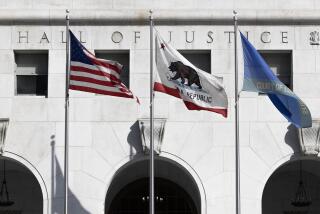D.A.’s Office Admits Secret Wiretapping
After insisting for months that its actions were appropriate and legal, the district attorney’s office Monday announced that it would immediately notify dozens of criminal defendants--some already serving prison terms--that their prosecutions resulted from previously undisclosed wiretaps.
The surprising action, disclosed in a press statement by Dist. Atty. Gil Garcetti, has direct bearing on 58 cases, with an unknown number of defendants, prosecuted by his major narcotics office since 1993.
Garcetti’s actions were viewed by defense attorneys as a significant acknowledgment.
“I think it is nothing less than a tacit admission that what they did in our case . . . was wrong,” said attorney Roger Rosen, one of three lawyers whose challenge of the wiretap policy was upheld by a judge. “And at most, it is an unequivocal admission that what they did was wrong.”
Garcetti also said Monday that his office will notify defendants in future cases about the existence of wiretaps while it continues to challenge a court ruling that requires disclosure of such surveillance.
He said his office has filed a total of 85 cases in which wiretap surveillance techniques were used and in every case “the wiretap surveillance was judicially authorized and monitored.”
The defendants in the 27 cases in which surveillance revealed “exculpatory information”--information that could aid their cases--were notified that their prosecutions resulted from wiretaps, Garcetti said. In the 58 cases where defendants were not notified, “the wiretap surveillance revealed no exculpatory information,” Garcetti said.
But Rosen said, “It’s not up to Gil Garcetti to decide what is exculpatory evidence and what is not.”
Public Defender Michael P. Judge noted that his office--the largest public defender’s office in the nation--will continue pressing to determine how many prosecutions may have been affected by the district attorney’s policy.
“The 58 cases . . . is the D.A.’s estimate regarding the cases that perhaps should be reviewed, but we don’t concede that at all,” he said. “In fact, it is essential that we proceed to ascertain the full dimension of the problem.”
Garcetti’s statement is in response to a March ruling by Los Angeles Superior Court Judge Gregory Alarcon.
“We’ve been reviewing the ruling and we just recently completed reviewing cases and how they impacted the ruling,” Pipkin said. The case that led to Alarcon’s ruling was a 1996 narcotics bust. According to court records, Los Angeles police arrested Lauro Gaxiola, Antonio Gastelum and Carlos Lobo allegedly for attempting to sell cocaine--estimated at 193 kilograms--from a Hacienda Heights residence.
Alarcon’s March ruling rocked Los Angeles’ legal and law enforcement circles. After months of legal wrangling, he ordered the district attorney’s office to turn over a wiretap application that--through a backdoor police procedure known as a “hand-off”--led to the 1996 arrests of Gaxiola, Gastelum and Lobo and seizure of about $20 million worth of cocaine.
At the heart of the case is how LAPD narcotics detectives--with the guidance of the district attorney’s office--put together drug cases originating in wiretap information passed from one group of investigators to another.
As outlined in court documents, when LAPD detectives on surveillance glean information about a possible new suspect, they sometimes “hand off” the tip to another set of detectives in the department without identifying its source--in this case, a wiretap.
The second group of detectives can then launch an investigation that, if it results in arrests, would not expose the ongoing wiretap--or allow attorneys representing the accused to challenge the legality of the electronic search because they would not be made aware of its existence.
More to Read
Sign up for Essential California
The most important California stories and recommendations in your inbox every morning.
You may occasionally receive promotional content from the Los Angeles Times.










